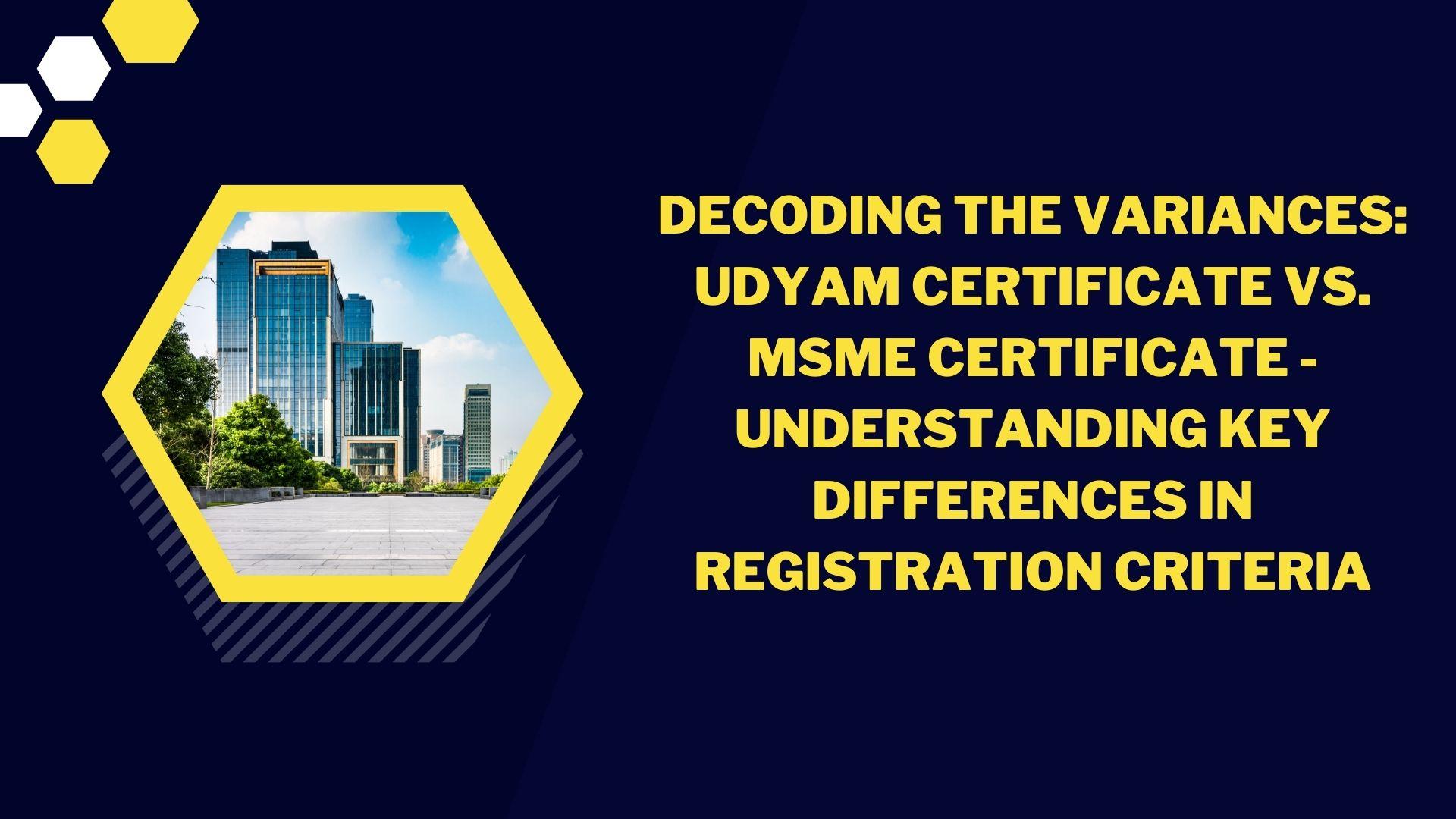In the landscape of business and entrepreneurship in India, the Small and Medium Enterprises (SME) sector plays a pivotal role in driving economic growth and employment generation. To promote and support the growth of these enterprises, the Government of India has introduced various schemes and certifications, such as the Udyam Certificate and the MSME Certificate. While both certificates aim to empower and facilitate SMEs, understanding their disparities in registration criteria is crucial for entrepreneurs navigating the regulatory environment.
Introduction
The Udyam Registration was introduced in 2020 to replace the erstwhile MSME registration process. This transition brought forth a new set of norms and criteria, marking significant differences between the Udyam Certificate and the previous MSME Certificate. Delving into the core distinctions between these certifications is imperative for businesses to make informed decisions regarding their registration preferences.
Eligibility Criteria
The fundamental variance between the Udyam Certificate and the MSME Certificate lies in their eligibility criteria. Under the Udyam Registration, the classification of enterprises is based on their annual turnover and investment in plant & machinery or equipment. Micro, Small, and Medium Enterprises are categorized differently based on these financial parameters. In contrast, the MSME Certificate focused solely on investment in plant & machinery for classification.
Registration Process and Documentation
Another pivotal difference is seen in the registration process and the requisite documentation. The Udyam Registration process is streamlined and online-oriented, demanding Aadhaar details and self-declaration of business-related information. Conversely, the earlier MSME Certificate necessitated a more extensive set of documents, including business PAN, GST details, and previous years’ financial statements.
Validity and Renewal
Validity and renewal criteria also set these certificates apart. The Udyam Certificate holds lifetime validity, provided the enterprise sustains the eligibility criteria. On the contrary, the MSME Certificate required renewal after a certain period, subject to the enterprise meeting specific conditions at the time of renewal.
Benefits and Support
Both certificates offer access to government schemes, subsidies, and support systems tailored for SMEs. However, the Udyam Certificate’s introduction brought additional benefits, including easier access to credit, preference in government tenders, and enhanced market opportunities.
Financial Criteria and Classification
The Udyam Registration introduced a dynamic shift in classification criteria by incorporating turnover alongside the investment in plant & machinery. Micro, Small, and Medium Enterprises are now categorized based on both these parameters, ensuring a more comprehensive assessment of an enterprise’s scale and potential. Contrastingly, the MSME Certificate relied solely on the investment in plant & machinery, which sometimes limited the scope of evaluating the true economic size of an enterprise.
Simplified Registration Process
One of the significant advantages of the Udyam Registration is its simplified and digitized process. The online platform allows for hassle-free registration, reducing paperwork and bureaucracy. This transformation aimed to make registration more accessible and less time-consuming for entrepreneurs. In contrast, the previous MSME registration process was comparatively more complex, demanding a multitude of documents and manual submissions.
Documentation Requirements
The Udyam Registration brought a paradigm shift in documentation requirements. It streamlined the process by necessitating minimal documents, primarily focusing on self-declaration and Aadhaar details. This transition significantly reduced the administrative burden previously associated with compiling extensive paperwork for MSME registration.
Validity and Renewal
The Udyam Certificate, once obtained, holds lifelong validity, provided the enterprise sustains the eligibility criteria. This eliminates the need for frequent renewals, providing a sense of continuity and stability to businesses. Conversely, the MSME Certificate required renewal after a certain period, subjecting enterprises to re-verification and potential reclassification, causing administrative disruptions.
Access to Benefits and Support
Both certificates offer access to government schemes and support systems. However, the Udyam Certificate introduced additional benefits such as improved access to credit, priority in government tenders, and enhanced market opportunities. These added advantages have further incentivized businesses to opt for Udyam Registration over the erstwhile MSME Certification.
Note: You Can Apply for Print Udyog Aadhaar Certificate
Conclusion
The Udyam Certificate and the MSME Certificate are instrumental in providing recognition and support to small and medium-sized enterprises. However, understanding their distinctive registration criteria is crucial for entrepreneurs seeking to leverage the benefits provided by these certifications. The transition from MSME to Udyam brought about significant changes in eligibility, documentation, validity, and associated benefits. Hence, it is essential for SMEs to comprehensively comprehend these variances to make informed choices aligning with their business goals.
The Udyam Certificate stands as a pivotal step towards a more inclusive and streamlined system, aiming to bolster the growth and development of the SME sector in India.
The journey of entrepreneurship demands informed decisions. Understanding the nuances between the Udyam Certificate and the MSME Certificate is not just about compliance but a strategic move towards leveraging government support for sustained business growth and development.



